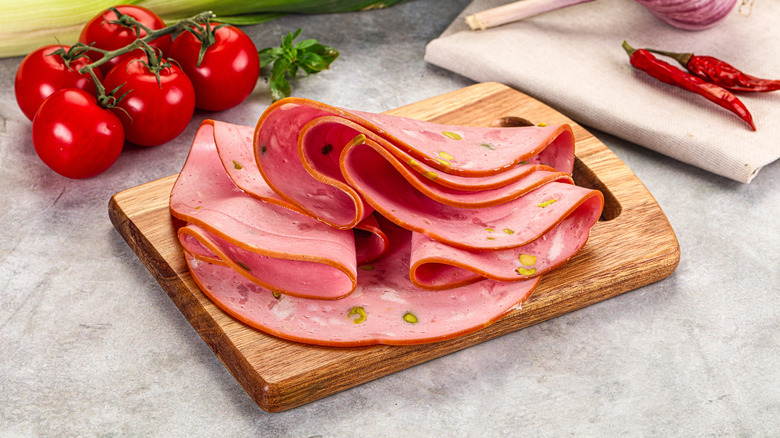Bologna Meat Vs Mortadella: What's The Actual Difference?
Just as bourbon and whiskey may be more different than you think, bologna meat and mortadella share some similarities but have disparate compositions and tastes. Visually, it is hard to mistake one for the other, with bologna's uniform appearance contrasting with the sizeable chunks of fat mixed into mortadella. Both cold cuts have Italian origins and contain ground meat formed into a sausage before it is sliced, yet the taste, texture, and type of protein used are key factors that separate the two.
Bologna typically consists of beef and pork trimmings ground into a pasty substance and packed into a sausage casing before being cooked. The ratios of the meat used can vary, but there can't be visible fat in its makeup. Ever wonder what hot dogs are really made of? Essentially, it is bologna meat, albeit formed into a different shape.
Conversely, mortadella is made only from pork. It is also ground and placed in a sausage casing, but the main contrast from bologna lies in the chunks of fat, pistachios, and sometimes peppers that break up the meat. Whereas you should not be able to see any fat in bologna, mortadella must have a minimum of 15% pork fat in its composition.
The difference in taste is also starker than some realize. Bologna has a mild, sweet flavor with hints of pepper, nutmeg, coriander, and myrtle berry. Mortadella boasts a stronger pork flavor complemented with velvety bites of fat and the nutty taste of pistachio. Because of the stark divergence in taste, each meat works best in varying dishes.
The best ways to use these two Italian deli meats
Bologna's uniform texture and mildly spiced taste work best with fare that incorporates various other flavors in the dish. Cubed or shredded, it can be lightly dressed with a tangy blend of mayo and seasonings to make a bologna salad that is perfect for crackers, bread, or just eaten by the forkful. Making a cheesy casserole that includes the processed meat gives it a boost of protein while maintaining the savory richness of the dish. One often underappreciated use for bologna is making a Southern classic — the fried bologna sandwich. Adding a touch of crispy char to the meat by frying it firms the typically soft consistency and accents the salty pork flavor that is elevated with mustard and pickle chips.
Mortadella, with its bolder pork flavor and silky structure, is a meat that doesn't need as much help in the flavor department. It is a type of meat that can be enjoyed on a charcuterie board filled with crackers, nuts, and fresh fruit. Thinly sliced mortadella also makes an excellent substitute for Canadian bacon on a pizza. With cheese placed over the meat, it retains most of its velvety character, while the exposed edges crisp up for a delightful contrast of texture. You could also swap bacon for mortadella in a carbonara by slicing it into strips and frying them until they become crispy enough to stand up to the creamy pasta. Although mortadella and bologna meat can each be used for a simple cold sandwich, anyone telling you they are essentially the same thing is feeding you a load of phony baloney.

